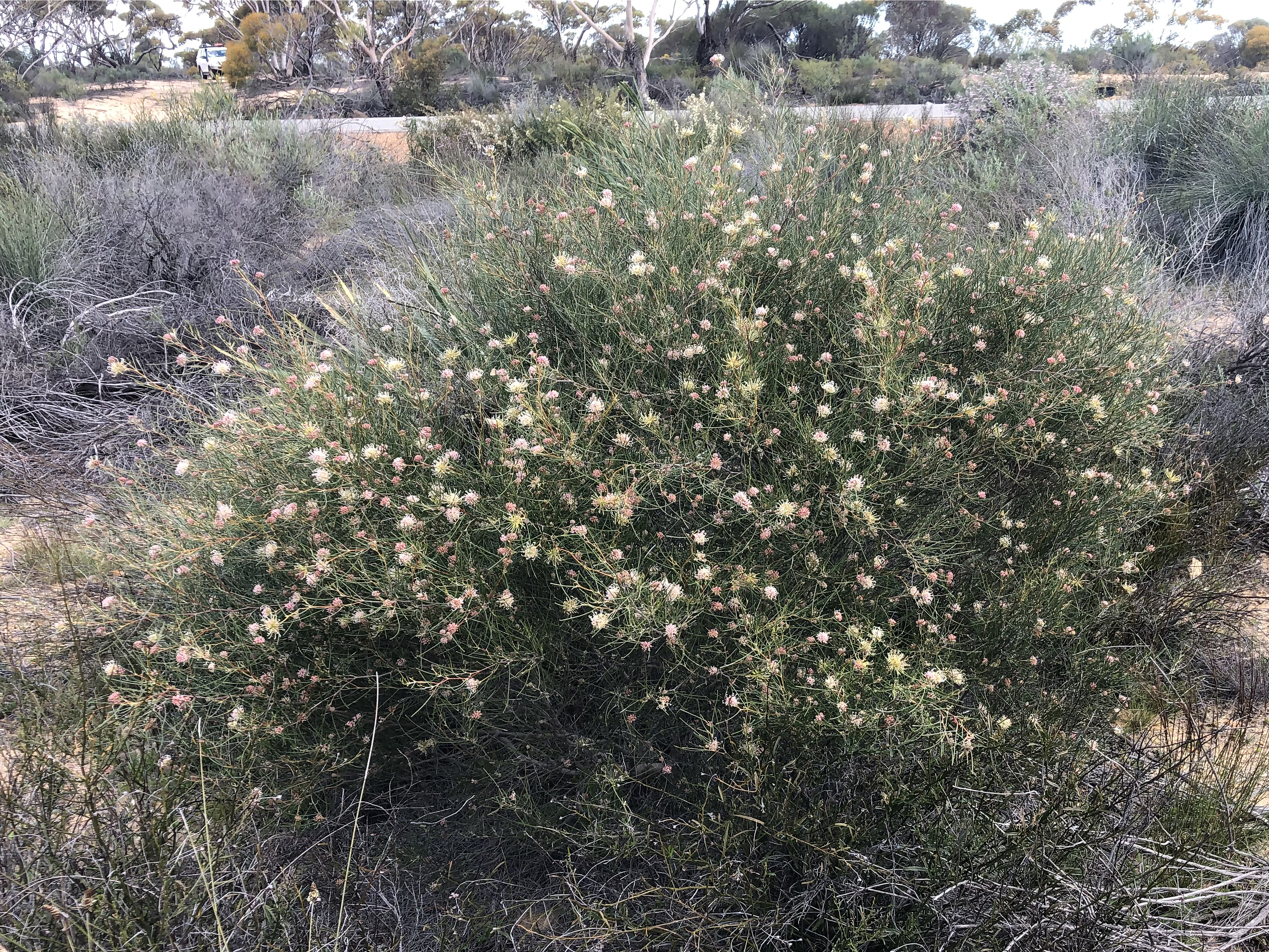Grevillea Hakeoides on:
[Wikipedia]
[Google]
[Amazon]
 ''Grevillea hakeoides'' is a species of flowering plant in the family
''Grevillea hakeoides'' is a species of flowering plant in the family
 ''Grevillea hakeoides'' is a species of flowering plant in the family
''Grevillea hakeoides'' is a species of flowering plant in the family Proteaceae
The Proteaceae form a family of flowering plants predominantly distributed in the Southern Hemisphere. The family comprises 83 genera with about 1,660 known species. Together with the Platanaceae and Nelumbonaceae, they make up the order Pro ...
and is endemic to the south-west of Western Australia. It is a spreading shrub with flat, linear or more or less-cylindrical leaves and dome-shaped groups of flowers, the colour varying according to subspecies.
Description
''Grevillea diversifolia'' is a spreading shrub that typically grows to a height of and has many branches. Its adult leaves are linear or more or less cylindrical, long and wide with two longitudinal grooves. The flowers are arranged in erect, dome-shaped groups on a rachis long, thepistil
Gynoecium (; ) is most commonly used as a collective term for the parts of a flower that produce ovules and ultimately develop into the fruit and seeds. The gynoecium is the innermost whorl of a flower; it consists of (one or more) ''pistils'' ...
long, the flower colour varying with subspecies. Flowering occurs from July to October and the fruit is an oblong follicle long.
Taxonomy
''Grevillea hakeoides'' was first formally described in 1848 by Carl Meissner in Johann Georg Christian Lehmann's ''Plantae Preissianae
''Plantae preissianae sive enumeratio plantarum quas in australasia occidentali et meridionali-occidentali annis 1838-1841 collegit Ludovicus Preiss'', more commonly known as ''Plantae preissianae'', is a book written by Johann Georg Christian Leh ...
'' from specimens collected by James Drummond near the Swan River. The specific epithet
In taxonomy, binomial nomenclature ("two-term naming system"), also called nomenclature ("two-name naming system") or binary nomenclature, is a formal system of naming species of living things by giving each a name composed of two parts, bot ...
(''hakeoides'') means "'' Hakea''-like".
In 1986 Donald McGillivray described two subspecies in his book, ''New Names in Grevillea (Proteaceae)'', and the names are accepted by the Australian Plant Census:
*''Grevillea hakeoides'' Meisn. subsp. ''hakeoides'' has more or less cylindrical leaves usually long and wide, and greenish-white to creamy-grey or pinkish flowers;
*''Grevillea hakeoides'' subsp. ''stenophylla'' McGill.
Donald John McGillivray (20 August 1935 – 17 August 2012) in New South Wales, Australia, usually known as D.J. McGillivray, was an Australian botanical taxonomist. He was trained in forestry, and became interested in plant taxonomy just before ...
has flat, linear leaves long and wide, and silvery-grey to white flowers. Subspecies ''stenophylla'' was previously known as ''Grevillea stenophylla'' W.Fitzg.
William Vincent Fitzgerald, (21 July 1867 – 6 August 1929) was an Australian botanist. He described five genera and about 210 species of plants from Western Australia, including 33 ''Acacia'' and several ''Eucalyptus'' species. He also collect ...
Distribution and habitat
Subspecies ''hakeoides'' grows in open woodland or tall shrubland in scattered location between Moora, theWongan Hills
Wongan Hills is a range of low flat-topped hills in the Avon Wheatbelt bioregion of Western Australia. It is located at , in the Shire of Wongan–Ballidu.
History
The range was first recorded in 1836 by Surveyor General of Western Australia Jo ...
, Tammin and Lake Grace
A lake is an area filled with water, localized in a basin, surrounded by land, and distinct from any river or other outlet that serves to feed or drain the lake. Lakes lie on land and are not part of the ocean, although, like the much larger ...
in the Avon Wheatbelt, Mallee and Yalgoo biogeographic regions of south-western Western Australia.
Subspecies ''stenophylla'' grows in heath, mallee heath or open shrubland, from Dirk Hartog Island to Watheroo
Watheroo is a small town in the Wheatbelt region of Western Australia. There are 137 residents, according to the .
History
Land in the area was settled by James Oliver in 1851, the area was surveyed in 1871 and the name Watheroo was charted fo ...
and inland as far as Paynes Find in the Avon Wheatbelt, Carnarvon, Coolgardie, Geraldton Sandplains, Mallee, Murchison, Swan Coastal Plain
The Swan Coastal Plain in Western Australia is the geographic feature which contains the Swan River as it travels west to the Indian Ocean. The coastal plain continues well beyond the boundaries of the Swan River and its tributaries, as a geol ...
and Yalgoo biogeographic regions.
Conservation status
''Grevillea hakeoides'' is listed as Least Concern on theIUCN Red List of Threatened Species
The International Union for Conservation of Nature (IUCN) Red List of Threatened Species, also known as the IUCN Red List or Red Data Book, founded in 1964, is the world's most comprehensive inventory of the global conservation status of biologi ...
. Both subspecies of ''G. hakeoides'' are listed as "not threatened" by the Government of Western Australia Department of Biodiversity, Conservation and Attractions.
The species has a widespread distribution and a stable population, though historically, much of its range within the Wheatbelt region of Western Australia has been reduced. In this area, much of the population is primarily limited to road verges where it is threatened by altered fire regimes, clearance and competition with invasive weed species. These threats are currently not substantial enough to affect the general population.
See also
* List of Grevillea speciesReferences
{{Taxonbar, from=Q15580146 hakeoides Endemic flora of Western Australia Eudicots of Western Australia Proteales of Australia Taxa named by Carl Meissner Plants described in 1848